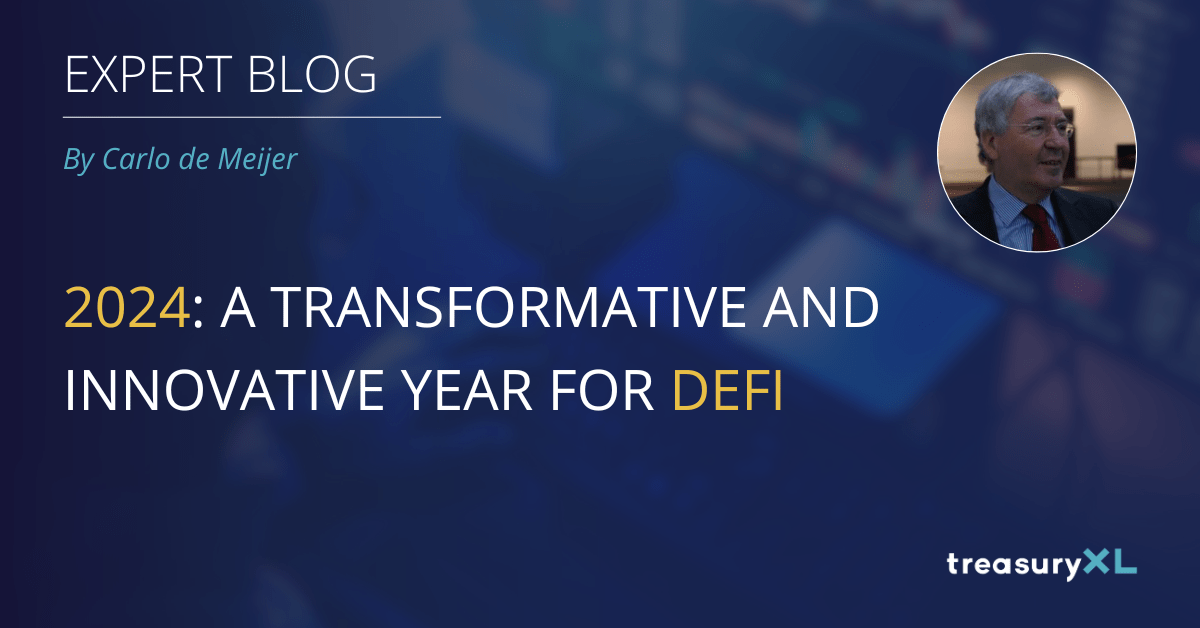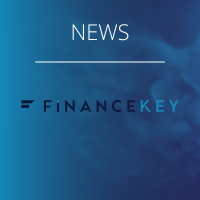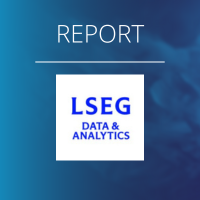Recent figures related to the DeFi market are showing a firm revival from the dip in 2022 and 2023. And that is not surprising.
Upcoming regulation, the emergence of various innovative solutions and technology advancements that address real-world financial needs are fuelling a revival of DeFi . These trends are thereby solving the main existing challenges and offering unprecedented opportunities for transforming the DeFi environment.
In this blog we will go into more detail into the various innovations and technological improvements, highlighting the latest projects, what these involve, what they may bring and what is their potential to revolutionize DeFi.
DEFI: Present state
Accelerated by the dramatic 2022 collapse of Luna and the loss of value from most governance tokens enthusiasm for DeFi has waned. Users increasingly moved from DeFi to more sustainable ‘real yield’ solutions.
However, fundamental shifts including regulatory clarity and technological innovative advances are occurring, that are fuelling a great revival in 2024. The decentralized finance (DeFi) sector has staged a remarkable comeback, solidifying its position as a cornerstone of the cryptocurrency ecosystem. This growth is driven by the growing transparency, security, and accessibility that DeFi offers compared to traditional finance, thanks to the various innovations and technological advances.
Total Value blocked
The DeFi ecosystem has seen explosive growth this year, with total value locked (TVL) in DeFi protocols reaching new heights. Total value locked (TVL) is the sum of all cryptocurrencies staked, loaned, deposited in a pool, or used for other financial actions across all of DeFi. Total Value Locked (TVL) in DeFi platforms now exceeding $ 100 billion, representing a significant recovery from the lows of late 2022, and about 80% of the all-time high of late 2021, indicating renewed investor confidence.
This suggests that while token prices have struggled, the underlying infrastructure of DeFi protocols remain robust. Furthermore, the stablecoin market cap has rebounded to $168 billion, over 90% of its 2022 highs, suggesting ongoing demand for decentralized dollar-pegged assets.
Daily DeFi trading volumes have also shown signs of recovery, averaging $6.9 billion since March 2024. This is about 70% of the peak volumes seen in November 2021, indicating that user engagement remains strong despite the price declines.
More diverse and multi-chain
The DeFi landscape has become significantly more diverse and multi-chain in recent years, moving beyond its initial dominance on the Ethereum network. While Ethereum still accounts for the majority of total value locked (TVL) across crypto networks, its market share has declined from over 95% during the DeFi Summer of 2020 to around 62% currently.
A substantial portion of TVL is now distributed across rival layer-1 blockchains like BNB Chain, Solana, and Tron, as well as various layer-2 networks. Additionally, the emergence of Bitcoin-based decentralized exchanges and the introduction of token standards like Ordinals and Runes have expanded the DeFi ecosystem to incorporate Bitcoin-based applications.
Technological advances: key innovative trends
One of the key drivers behind the DeFi sector’s resurgence is the significant technological advancements that have been made.
Today, we’re seeing the rise of innovative trends. The innovation within DeFi is set to continue, with new products and services expected to emerge in 2024b and beyond, including liquid staking protocols, restaking, native yield generation, cross-chain solutions and the tokenization of real-world assets, that are boosting the adoption of the technology. Additionally, we might see further development in DeFi infrastructure, improving scalability and reducing transaction costs.
These technological advancements could enable new use cases, that may include more sophisticated financial instruments such as decentralised derivatives, insurance and credit markets. They may improve the overall user experience, addressing one of DeFi’s key pain points, making DeFi applications more efficient and accessible to a broader audience.
Evolution into DeFi 2.0
Decentralized Finance, or DeFi, continues to be a major force in the crypto space. However, in 2024, we are seeing the evolution into DeFi 2.0, which focuses on sustainability, improving scalability, improved security, and user experience via the introduction of user friendly interfaces aimed to attract mainstream users..
With this shift, innovations like layer-2 solutions and cross-chain interoperability are enhancing DeFi platforms, making them more accessible and efficient. Innovations thereby include better governance models, scalable infrastructure, and more robust smart contract designs.
Explosive growth of Liquid Restaking Tokens
An emerging transformative force is the spectacular growth of the liquid restaking market. By mid-2024 the total value locked in liquid restaking tokens (LRTs) ballooned to a staggering $ 13.8 billion compared to a modest $ 264 million at the beginning of the year.
Liquid restaking protocols represent a significant shift in how staking and DeFi operations are conducted. This by simplifying the complexities of traditional Ether staking that requires users to lock up their assets in a protocol to earn rewards thereby increasing capital efficiency.
Liquid staking platforms, such as the industry leader Eigenlayer, EtherF and Lido, allow users to stake their assets while maintaining their liquidity, as they receive equivalent liquid staking tokens in return, that can be deployed across other DeFi protocols, thereby unlocking additional value.
Towards greater incentivation: Points and Airdrops
We also see the growing use of incentives like tokenized rewards and crypto airdrops. They now play a crucial role in the DeFi ecosystem by boosting user participation and reinforcing liquidity. These airdrops usually serve as a marketing strategy, intending to spread awareness about a new cryptocurrency or to reward loyal customers.
Crypto airdrops refer to the process where crypto token creators distribute their tokens to wallet addresses free of charge. Airdrops are widely used to build communities and increase the visibility of new crypto projects. Many DeFi projects use these mechanisms to attract and retain users.
The received tokens can be a boon to an investor crypto portfolio as they can be traded or held as investments. Platforms like Blur, EigenLayer, and Ethena are notable examples.
Protocols like Uniswap are exploring fee-sharing mechanisms, which could set a precedent for other DeFi tokens to offer more tangible value to holders. This shift towards revenue sharing could transform DeFi tokens from purely speculative assets to productive financial instruments, attracting a new class of investors.
Cross-Chain Solutions
There is growing need of interoperability to allow different blockchain networks to communicate and interact with each other. This year we see the arrival of cross-chain bridges and interoperability protocols that will allow seamless asset transfers and interactions between various DeFi platforms.
This interoperability may enhance liquidity, user experience, and the overall efficiency of the DeFi ecosystem driving further adoption of DeFi services. These advancements make DeFi applications more efficient and accessible to a broader audience.
Platforms like Polkadot enable seamless communication between different blockchains, facilitating smoother transactions and allowing DeFi applications to scale beyond the limitations of a single network.
The Rise of Layer 2 Scaling Solutions
Scalability issues have long plagued major blockchain networks like Ethereum. Network scalability has been a challenge for DeFi, but cross-chain technology offers a solution. As the demand for DeFi services grows, the need for more scalable blockchain solutions becomes more critical. Cross-chain bridges enable seamless asset transfers between different blockchain networks.
There is a growing rise of Layer 2 scaling solutions to solve this issue. Layer 2 scaling solutions, are aimed to increase transaction throughput and reduce fees, which operate on top of existing blockchains like Ethereum. Layer 2 solutions aim to address the scalability issues of Layer 1 blockchains by processing transactions off-chain and then settling them on-chain. This method reduces congestion, lowers transaction fees, and increases throughput.
They make decentralized applications more accessible to a broader audience, particularly in terms of increased transaction speed and reduced transaction fees/cost. Layer 2 solutions will play a critical role in the continued growth of DeFi.
Projects like Equilibrium and Avalanche are already leveraging cross-chain functionality to offer a wider range of DeFi options.
Governance Tokens are empowering Users in DeFi Projects
Many DeFi platforms nowadays issue governance tokens, granting holders voting rights on the protocol’s development. This fosters community ownership within the DeFi ecosystem. Governance tokens underscore a shift towards user-centric DeFi protocols where token holders actively shape the platform’s future. Projects like Compound and Curve Finance have seen significant value growth in their governance tokens.
Innovative borrowing Protocols
Borrowing protocols are the cornerstone of the DeFi ecosystem. They provide essential financial services like lending and borrowing that drive the entire market. Platforms are thereby leading the way with innovative solutions that include zero-interest borrowing and yield on collateral. These protocols offer users the ability to borrow against their digital assets without incurring high fees, thereby democratizing access to capital and enabling more efficient financial management.
Liquidity Provision (LPs)
Perpetual liquidity pools are revolutionizing decentralized finance in 2024. Perpetual liquidity pools capitalize on real yields, offering a reliable option for traders looking to increase their leverage. These pools allow liquidity providers to earn real returns without the need to constantly monitor their positions.
With the introduction of concentrated liquidity pools users now have a choice when providing liquidity. Concentrated liquidity pools (sometimes referred to as V2 pools) are a fork of the Uniswap pools which are intended to provide liquidity providers with more flexibility and capital efficiency. They are a way for liquidity providers to make their capital work harder for them, provide them with more options, and to some extent mitigate risk.
Evolution of DeFi Derivatives
Another upcoming innovative trend are DeFi derivatives. DeFi derivatives are financial instruments whose value is derived from an underlying asset, such as cryptocurrencies, commodities, or fiat currencies. These derivatives include products like futures, options, and swaps. They are becoming more sophisticated, with new products emerging that offer traders advanced options for hedging, speculation, and risk management. The development of DeFi derivatives will attract more sophisticated traders to the DeFi space, thereby increasing market depth and providing new tools for portfolio management.
Tokenization of Real-World Assets (RWAs)
Another trend that is gaining significant traction is the tokenization of real-world assets (RWAs), such as real estate, commodities, and securities and integrating them into DeFi protocols, making them tradable on blockchain networks. This process allows these assets to be divided into smaller units, unlocking new opportunities, providing broader access to a wider range of investors, both retail and institutional.
Real-world applications of blockchain technology, particularly within the DeFi space, are gaining traction indicating a maturation of the DeFi market, offering investors access to a broader range of traditional investment opportunities and unlocking new avenues for decentralized finance innovation.
Major players have already begun tokenizing traditional funds, signalling growing interest from mainstream finance. This move could bring trillions of dollars of liquidity into DeFi protocols.
Intent-based architecture is advancing
We also see the upcoming of so-called Intent-Based architecture. Intent-based architecture significantly simplifies user interactions with decentralized finance platforms. Instead of setting each transaction parameter, users can simply specify the desired outcome, via these user-focused models.
This approach removes technical complexities and allows for a smoother and more efficient user experience, resulting in fewer failed transactions. Crypto protocols like UniswapX and Aperture Finance well illustrate this innovation.
Decentralized Autonomous Organizations (DAOs) increasing popular
Decentralized Autonomous Organizations (DAOs) are becoming increasingly popular as a governance model for DeFi protocols in the DeFi space, with enhanced mechanisms for community participation, decision-making, and protocol upgrades.
A DAO is an organization governed by smart contracts and token holders rather than a central authority. Decisions are made through a voting system, ensuring that all stakeholders have a voice in the project’s future. These organizations allow communities to have a direct say in the management and direction of DeFi projects
This year a surge in the number of DAOs managing various aspects of DeFi projects is expected. These DAOs will enable more community-driven decision-making processes, promoting transparency and decentralization.
DAOs will continue to grow in influence, shaping the governance of DeFi projects and ensuring that they remain decentralized. The success of DAOs could lead to broader adoption of decentralized governance in other sectors.
DAOs such as Uniswap Dao and Maker Dao, are gaining momentum as a governance model in the DeFi space. As of June 2024 almost 40% (1.95b) of the total supply of its collateralized stablecoin DAI is now backed by these RWA collaterals as of June 2024.
Enhanced Security Measures
As DeFi grows, the need for improved security measures becomes more pressing. 2024 will likely see DeFi projects prioritizing security, employing more rigorous auditing processes, and integrating advanced security protocol s.
We will see more robust security frameworks being implemented through safe mining operations and sophisticated smart contracts. The implementation of decentralized identity protocols for secure and privacy-preserving user authentication, may enable seamless access to DeFi services while protecting personal data.
We further see the expansion of decentralized insurance protocols and risk management solutions to protect users against smart contract vulnerabilities, hacks, and market volatility.
And there is the development of DeFi platforms and tools that ensure compliance with evolving regulatory frameworks, fostering trust and legitimacy within the broader financial ecosystem. This focus on security will help build trust among users and attract more institutional investors.
Enhanced security will build trust in DeFi, encouraging more users and institutions to participate in the ecosystem. It will also reduce the risk of high-profile exploits, which have previously caused significant market disruptions.
Adoption of Central Bank Digital Currencies (CBDCs)
Central Bank Digital Currencies (CBDCs) are becoming a significant trend. They continue to gain traction worldwide as a growing number of governments explore the benefits of digital currencies. This trend is driven by the need for more efficient payment systems, financial inclusion, and enhanced monetary policy tools.
This year we expect to see more countries launching or piloting their own CBDCs to complement or replace physical cash. China’s digital yuan and the European Central Bank’s digital euro are leading examples, with many other countries following suit.
And there are many more innovations
And here it does not stop. There are many more innovations that may impact the DeFi-sector, creating new opportunities for users and developers alike.
Such as the setup of Decentralized Oracle Networks: Advancements in decentralized Oracle solutions may provide reliable off-chain data feeds for smart contracts, enhancing the security and functionality of DeFi applications.
And the upcoming of Decentralized Exchanges (DEXs) that are central to DeFi,. They allow users to trade cryptocurrencies without centralized intermediaries. Automated Market Makers (AMMs) enhance DEXs by providing liquidity pools, where users can lend their crypto assets in exchange for interest. AMMs are critical in driving DeFi growth and creating a more liquid trading environment, with advanced features such as dynamic pricing models, liquidity aggregation, and impermanent loss mitigation strategies to optimize decentralized trading experiences.
And the shift towards revenue sharing: Protocols like Uniswap are exploring fee-sharing mechanisms, which could set a precedent for other DeFi tokens to offer more tangible value to holders. This shift towards revenue sharing could transform DeFi tokens from purely speculative assets to productive financial instruments, attracting a new class of investors.
What may these innovations bring?
Mainstream Adoption: growing institutional interest
In 2024, we anticipate a significant increase in mainstream adoption, with more individuals and financial institutions exploring DeFi products and services, with some already launching tokenized funds on Ethereum.
Institutional DeFi adoption involves large financial institutions, such as banks and hedge funds, integrating DeFi protocols into their operations or creating their DeFi solutions. These institutions are recognizing the potential of DeFi to offer high yields, greater transparency, and more efficient financial services.
Financial institutions, in particular, are likely to develop their DeFi strategies, offering new products that blend traditional finance with DeFi elements. This institutional interest could further bring legitimacy and significant capital inflows to the sector.
As more institutions enter the DeFi space, we may expect greater liquidity, more robust security measures, and the development of new financial products tailored to institutional needs.
Integration with Traditional Finance
A major trend to watch is the increasing integration of DeFi with traditional finance (TradFi). Financial institutions are exploring ways to incorporate DeFi protocols into their operations, offering hybrid products that leverage the benefits of both systems, with some already launching tokenized funds on Ethereum. This integration will likely lead to more collaborative efforts between DeFi projects and traditional financial entities further boosting innovation. As DeFi protocols become more interconnected with existing financial infrastructure, the potential for cross-border transactions and seamless asset transfer grows exponentially.
These trends highlight the dynamic landscape of DeFi. From integrating traditional financial instruments DeFi is continuously pushing boundaries and reshaping finance. As these trends evolve, expect more innovative solutions to emerge, solidifying DeFi’s position as a powerful force in the future of finance.
Forward thinking
2024 promises to be a transformative year for DeFi, in the way we conceive and use financial services, with significant advancements in regulation, security, interoperability, and user experience. Innovations as described in this blog like liquid restaking tokenization and protocols, native yield and RWA tokenization are creating a more vibrant DeFi ecosystem.
The innovation process within DeFi is set to continue, opening up new possibilities for DeFi applications, with new use cases, products and services expected to emerge. These may include more sophisticated financial instruments such as decentralized derivatives, insurance, and credit markets. This may improve the overall user experience, thereby addressing one of DeFi’s key pain points.
Additionally, we might see further development in DeFi infrastructure, improving security, scalability and reducing transaction costs. As the ecosystem matures, DeFi is set to play a more prominent role in the global financial landscape, offering new opportunities and challenges for users and institutions alike.












